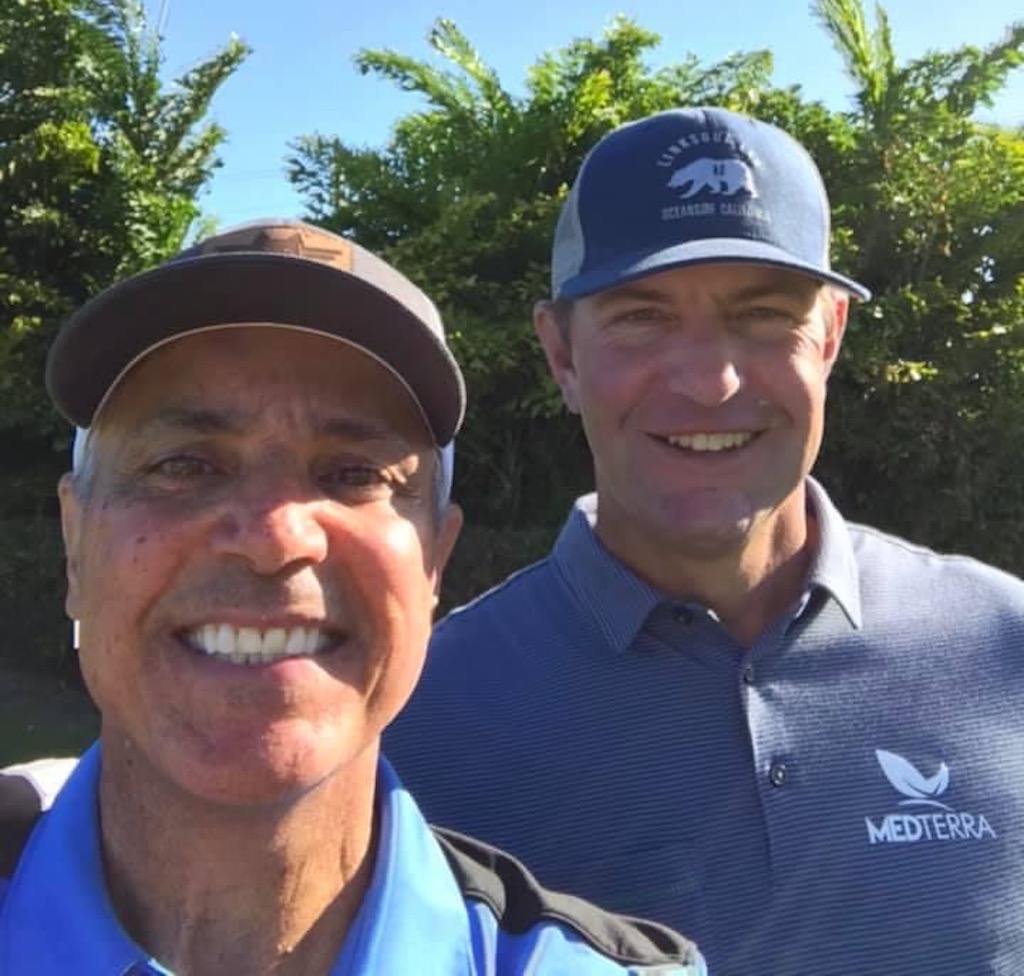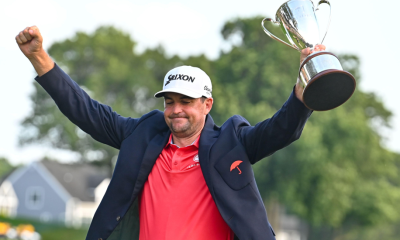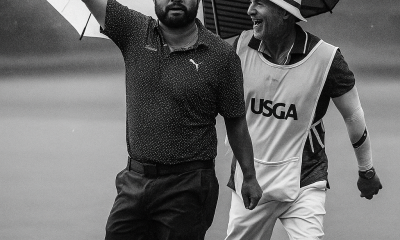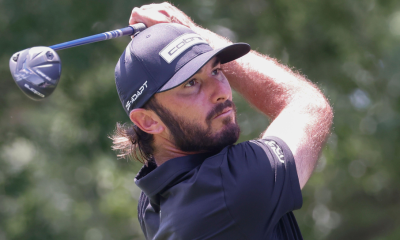Opinion & Analysis
Inside the PGA Tour ropes with Lucas Glover

I was fortunate to have played with Lucas Glover during the pro-am in the Puerto Rico Open a couple of years ago. Playing with PGA Tour players on superb golf courses in superlative conditions is a thrill. It never gets old. But it takes on indelibly unforgettable status when your professional teammate is a first-class human like Glover.
Before extolling Glover’s many virtues, here’s some context for my claiming to be somewhat of a PGA Tour pro-am expert.
Having played in roughly 15 of them, I know a good playing partner when I meet him. These include rising young bucks like Vincent Norrman and Joseph Bramlett, veteran journeymen like John Senden and Scott Brown, and icons, major championship winners, and former world no. 1 ranked players like John Daly, David Duval, and Loren Roberts (the “Boss of the Moss!”).
Each of them connected with us beyond the obligatory “Nice shot!” or “Great putt!” compliments they routinely pay to amateur partners. Considering that many of us are bogey golfers, that’s no small feat. Week in. Week out. Year over year. It must be numbing. But you couldn’t tell it by how those guys interacted with us.
Like life, not everything’s perfect in pro-ams, however. There were a couple of players who were preoccupied and not ready, interested, or able to put their best foot forward.
In one case that was due to a wrist injury the player was battling (Ian Leggatt). Physical and emotional pain will do that to a person. Not that Leggatt was rude or standoffish to us. But he was hurting, not playing well, and feeling understandably down. In another, it was pure selfishness, like when a player left the course with two holes to play. He had grown weary of the slow pace, the lift, clean, and place soggy conditions. (Who hadn’t?) He didn’t say goodbye to the amateur group. Instead, he said to me, “I’ve had enough; tell the guys I said thanks,” then split.
Obviously, my guys were bummed — for most amateurs, playing inside the ropes at a PGA Tour pro-am event is a thrilling, pinnacle golf moment (like making a hole-in-one). So when they learned that the player was no more, to say it was a buzzkill is an understatement. Fortunately, Fred Funk was in the group behind ours. When we explained what happened, he insisted that we finish the round with him and his group. That took our pro-am experience from the outhouse to the penthouse.
Then there are some players who are just different. Unique. John Daly and David Duval for example. Daly was a fabulous partner who engaged with we amateur chops non-stop. As for Duval, after learning that I had been in the 82nd Airborne Division during my time in the U.S. Army, all he wanted to do was talk foreign policy and the threat of war. “What’s next?,” he asked rhetorically. “Iran? North Korea?” Cerebral guy who was more interested in that “real-world” subject than the game we were playing. “Hey David – we gotta go – it’s our turn to hit!”
Suffice it to say, there’s a spectrum of people, players, and personalities that determine how each pro-am plays out. And Glover stands foremost on my Mount Rushmore of PGA Tour pro-am partners. Glover asked everyone where they were from, what they did for a living, about their families, and did so in a casual yet genuinely interested way.
Amateurs play different tees from the PGA Tour pros. But Glover would hit and then walk briskly up to our tees so that he was there in time to fist bump teammates after good shots and to share encouraging words that made for a relaxing, fun, we’re-all-in-this-together vibe. As a veteran pro-am participant who is usually the leader of our amateur groups, I’ve learned to play quickly so not to slow down the pros, including having one of us teeing up moments after the pro’s shot is airborne. Glover was not to be denied, however. He started to jog up to the amateur tees so he could cheerlead in real time. And in between shots, he chatted about an array of things, the state of the game, the latest news from the PGA Tour, his beloved Clemson. You name it, he was game for it.

The author with Lucas Glover during the 2021 Puerto Rico Open PGA TOUR pro-am.
After Glover won two weeks ago he teared up (along with his young daughter) when speaking about being away from his family while grinding on the road week after week, that the win would enable him to be home more. Based on my experience playing with him, that struck me as 100 percent genuine. While playing golf at the top level has taken him around the world and provided him with great professional fulfillment and financial benefits (and a U.S. Open championship!), he’s also suffered crushing slumps and the commensurate self-doubt that accompanies them. The polarizing highs and lows can be too much for some. For Glover, it has made him more real and uplifting. Perspective, earnestness, and gratitude have a way of doing that to a person.
Now that Glover has won in consecutive weeks, catapulting himself to the top echelon of his craft in his mid-40s, he can pick and choose his schedule with much more latitude. That’s a well-earned, priceless byproduct of his success. And it’s the best possible scenario for him as a dad.
Karma is real. Sometimes good guys do finish first. And if you ever get a chance to play in a pro-am with Glover, don’t hesitate. You’ll be better for it.
Opinion & Analysis
The 2 primary challenges golf equipment companies face

As the editor-in-chief of this website and an observer of the GolfWRX forums and other online golf equipment discourse for over a decade, I’m pretty well attuned to the grunts and grumbles of a significant portion of the golf equipment purchasing spectrum. And before you accuse me of lording above all in some digital ivory tower, I’d like to offer that I worked at golf courses (public and private) for years prior to picking up my pen, so I’m well-versed in the non-degenerate golf equipment consumers out there. I touched (green)grass (retail)!
Complaints about the ills of and related to the OEMs usually follow some version of: Product cycles are too short for real innovation, tour equipment isn’t the same as retail (which is largely not true, by the way), too much is invested in marketing and not enough in R&D, top staffer X hasn’t even put the new driver in play, so it’s obviously not superior to the previous generation, prices are too high, and on and on.
Without digging into the merits of any of these claims, which I believe are mostly red herrings, I’d like to bring into view of our rangefinder what I believe to be the two primary difficulties golf equipment companies face.
One: As Terry Koehler, back when he was the CEO of Ben Hogan, told me at the time of the Ft Worth irons launch, if you can’t regularly hit the golf ball in a coin-sized area in the middle of the face, there’s not a ton that iron technology can do for you. Now, this is less true now with respect to irons than when he said it, and is less and less true by degrees as the clubs get larger (utilities, fairways, hybrids, drivers), but there remains a great deal of golf equipment truth in that statement. Think about it — which is to say, in TL;DR fashion, get lessons from a qualified instructor who will teach you about the fundamentals of repeatable impact and how the golf swing works, not just offer band-aid fixes. If you can’t repeatably deliver the golf club to the golf ball in something resembling the manner it was designed for, how can you expect to be getting the most out of the club — put another way, the maximum value from your investment?
Similarly, game improvement equipment can only improve your game if you game it. In other words, get fit for the clubs you ought to be playing rather than filling the bag with the ones you wish you could hit or used to be able to hit. Of course, don’t do this if you don’t care about performance and just want to hit a forged blade while playing off an 18 handicap. That’s absolutely fine. There were plenty of members in clubs back in the day playing Hogan Apex or Mizuno MP-32 irons who had no business doing so from a ballstriking standpoint, but they enjoyed their look, feel, and complementary qualities to their Gatsby hats and cashmere sweaters. Do what brings you a measure of joy in this maddening game.
Now, the second issue. This is not a plea for non-conforming equipment; rather, it is a statement of fact. USGA/R&A limits on every facet of golf equipment are detrimental to golf equipment manufacturers. Sure, you know this, but do you think about it as it applies to almost every element of equipment? A 500cc driver would be inherently more forgiving than a 460cc, as one with a COR measurement in excess of 0.83. 50-inch shafts. Box grooves. And on and on.
Would fewer regulations be objectively bad for the game? Would this erode its soul? Fortunately, that’s beside the point of this exercise, which is merely to point out the facts. The fact, in this case, is that equipment restrictions and regulations are the slaughterbench of an abundance of innovation in the golf equipment space. Is this for the best? Well, now I’ve asked the question twice and might as well give a partial response, I guess my answer to that would be, “It depends on what type of golf you’re playing and who you’re playing it with.”
For my part, I don’t mind embarrassing myself with vintage blades and persimmons chasing after the quasi-spiritual elevation of a well-struck shot, but that’s just me. Plenty of folks don’t give a damn if their grooves are conforming. Plenty of folks think the folks in Liberty Corner ought to add a prison to the museum for such offences. And those are just a few of the considerations for the amateur game — which doesn’t get inside the gallery ropes of the pro game…
Different strokes in the game of golf, in my humble opinion.
Anyway, I believe equipment company engineers are genuinely trying to build better equipment year over year. The marketing departments are trying to find ways to make this equipment appeal to the broadest segment of the golf market possible. All of this against (1) the backdrop of — at least for now — firm product cycles. And golfers who, with their ~15 average handicap (men), for the most part, are not striping the golf ball like Tiger in his prime and seem to have less and less time year over year to practice and improve. (2) Regulations that massively restrict what they’re able to do…
That’s the landscape as I see it and the real headwinds for golf equipment companies. No doubt, there’s more I haven’t considered, but I think the previous is a better — and better faith — point of departure when formulating any serious commentary on the golf equipment world than some of the more cynical and conspiratorial takes I hear.
Agree? Disagree? Think I’m worthy of an Adam Hadwin-esque security guard tackle? Let me know in the comments.
@golfoncbs The infamous Adam Hadwin tackle ? #golf #fyp #canada #pgatour #adamhadwin ? Ghibli-style nostalgic waltz – MaSssuguMusic
Podcasts
Fore Love of Golf: Introducing a new club concept

Episode #16 brings us Cliff McKinney. Cliff is the founder of Old Charlie Golf Club, a new club, and concept, to be built in the Florida panhandle. The model is quite interesting and aims to make great, private golf more affordable. We hope you enjoy the show!
Opinion & Analysis
On Scottie Scheffler wondering ‘What’s the point of winning?’

Last week, I came across a reel from BBC Sport on Instagram featuring Scottie Scheffler speaking to the media ahead of The Open at Royal Portrush. In it, he shared that he often wonders what the point is of wanting to win tournaments so badly — especially when he knows, deep down, that it doesn’t lead to a truly fulfilling life.
View this post on Instagram
“Is it great to be able to win tournaments and to accomplish the things I have in the game of golf? Yeah, it brings tears to my eyes just to think about it because I’ve literally worked my entire life to be good at this sport,” Scheffler said. “To have that kind of sense of accomplishment, I think, is a pretty cool feeling. To get to live out your dreams is very special, but at the end of the day, I’m not out here to inspire the next generation of golfers. I’m not out here to inspire someone to be the best player in the world, because what’s the point?”
Ironically — or perhaps perfectly — he went on to win the claret jug.
That question — what’s the point of winning? — cuts straight to the heart of the human journey.
As someone who’s spent over two decades in the trenches of professional golf, and in deep study of the mental, emotional, and spiritual dimensions of the game, I see Scottie’s inner conflict as a sign of soul evolution in motion.
I came to golf late. I wasn’t a junior standout or college All-American. At 27, I left a steady corporate job to see if I could be on the PGA Tour starting as a 14-handicap, average-length hitter. Over the years, my journey has been defined less by trophies and more by the relentless effort to navigate the deeply inequitable and gated system of professional golf — an effort that ultimately turned inward and helped me evolve as both a golfer and a person.
One perspective that helped me make sense of this inner dissonance around competition and our culture’s tendency to overvalue winning is the idea of soul evolution.
The University of Virginia’s Division of Perceptual Studies has done extensive research on reincarnation, and Netflix’s Surviving Death (Episode 6) explores the topic, too. Whether you take it literally or metaphorically, the idea that we’re on a long arc of growth — from beginner to sage elder — offers a profound perspective.
If you accept the premise literally, then terms like “young soul” and “old soul” start to hold meaning. However, even if we set the word “soul” aside, it’s easy to see that different levels of life experience produce different worldviews.
Newer souls — or people in earlier stages of their development — may be curious and kind but still lack discernment or depth. There is a naivety, and they don’t yet question as deeply, tending to see things in black and white, partly because certainty feels safer than confronting the unknown.
As we gain more experience, we begin to experiment. We test limits. We chase extreme external goals — sometimes at the expense of health, relationships, or inner peace — still operating from hunger, ambition, and the fragility of the ego.
It’s a necessary stage, but often a turbulent and unfulfilling one.
David Duval fell off the map after reaching World No. 1. Bubba Watson had his own “Is this it?” moment with his caddie, Ted Scott, after winning the Masters.
In Aaron Rodgers: Enigma, reflecting on his 2011 Super Bowl win, Rodgers said:
“Now I’ve accomplished the only thing that I really, really wanted to do in my life. Now what? I was like, ‘Did I aim at the wrong thing? Did I spend too much time thinking about stuff that ultimately doesn’t give you true happiness?’”
Jim Carrey once said, “I think everybody should get rich and famous and do everything they ever dreamed of so they can see that it’s not the answer.”
Eventually, though, something shifts.
We begin to see in shades of gray. Winning, dominating, accumulating—these pursuits lose their shine. The rewards feel more fleeting. Living in a constant state of fight-or-flight makes us feel alive, yes, but not happy and joyful.
Compassion begins to replace ambition. Love, presence, and gratitude become more fulfilling than status, profits, or trophies. We crave balance over burnout. Collaboration over competition. Meaning over metrics.
Interestingly, if we zoom out, we can apply this same model to nations and cultures. Countries, like people, have a collective “soul stage” made up of the individuals within them.
Take the United States, for example. I’d place it as a mid-level soul: highly competitive and deeply driven, but still learning emotional maturity. Still uncomfortable with nuance. Still believing that more is always better. Despite its global wins, the U.S. currently ranks just 23rd in happiness (as of 2025). You might liken it to a gifted teenager—bold, eager, and ambitious, but angsty and still figuring out how to live well and in balance. As much as a parent wants to protect their child, sometimes the child has to make their own mistakes to truly grow.
So when Scottie Scheffler wonders what the point of winning is, I don’t see someone losing strength.
I see someone evolving.
He’s beginning to look beyond the leaderboard. Beyond metrics of success that carry a lower vibration. And yet, in a poetic twist, Scheffler did go on to win The Open. But that only reinforces the point: even at the pinnacle, the question remains. And if more of us in the golf and sports world — and in U.S. culture at large — started asking similar questions, we might discover that the more meaningful trophy isn’t about accumulating or beating others at all costs.
It’s about awakening and evolving to something more than winning could ever promise.






















DP
Aug 20, 2023 at 8:15 am
I want to know who walked off early
Dan Shepherd
Aug 28, 2023 at 4:33 pm
Choosing discretion, DP.
Dan Shepherd
Aug 16, 2023 at 9:11 pm
Duval was not chest beating, he was voicing concern about the threat of war at the time, I believe.
Bob
Aug 16, 2023 at 11:34 am
When some chestbeater rich idiot golfer like Duval wants to talk war, maybe they should enlist or send their own children.
Those of us who have been in real war, shot at others, and been shot at don’t talk about it. BTW, you aren’t a REAL veteran either unless this is you.
FK
Aug 17, 2023 at 4:37 am
You haven’t done a thing. You can tell by the trash you spew.